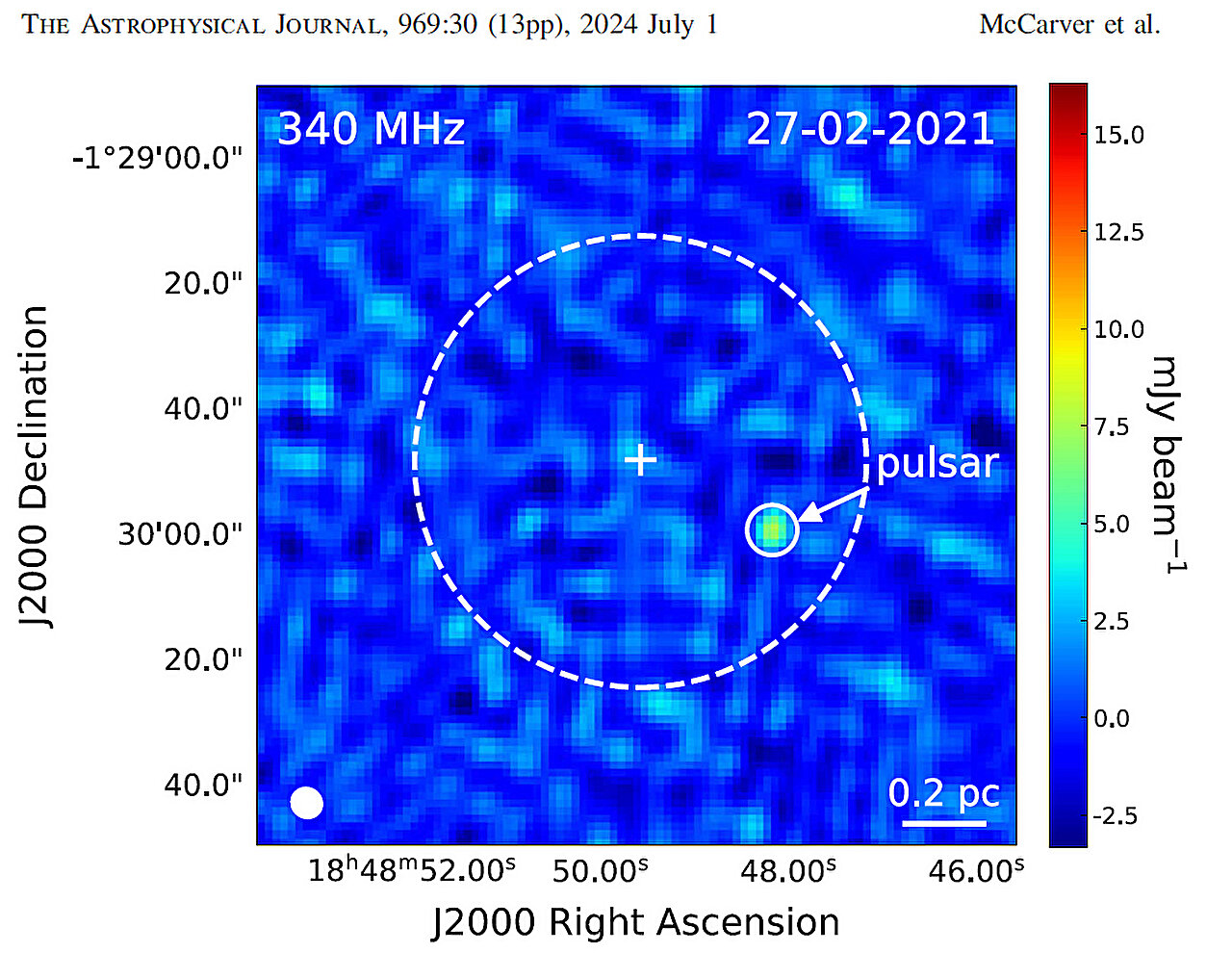VLITE 340 MHz image of GLIMPSE-C01 from February 27, 2021. The clean beam is shown as a white ellipse in the lower left corner and has dimensions of 5 0 × 4 7 with a position angle of 52°. The cross indicates the central position of GLIMPSE-C01. The dashed white circle shows the core radius of 36″. The location of the pulsar candidate is shown with a solid white circle. A scale bar indicating a linear magnitude of 0.2 pc (12 5), assuming a distance to GLIMPSE-C01 of 3.3 kpc, is shown in the lower right corner. Credit: National Radio Astronomy Observatory/NRL/Texas Tech
Amaris McCarver, an intern at the Remote Sensing Division of the U.S. Naval Research Laboratory (NRL), and a team of astronomers have discovered the first millisecond pulsar in the star cluster Glimpse-CO1 and recently published their findings in The astrophysical journal.
Pulsars are natural laboratories for studying the behavior of matter under extreme gravitational and magnetic fields, conditions that are difficult or impossible to replicate on Earth.
They also act as natural timekeepers. Precise timing of the observed pulses from a series of pulsars provides a way to detect gravitational waves propagating through our galaxy from the merging supermassive black holes that result from galaxy collisions. Some pulsars are observed to have a precision and stability comparable to our most precise atomic clocks. These pulsars have the potential to establish a “celestial GPS” system for satellite navigation in space.
McCarver’s team used images from the Karl G. Jansky Very Large Array (VLA) Low-band Ionosphere and Transient Experiment (VLITE) to search for new pulsars in 97 star clusters.
“It was exciting so early in my career to see a speculative project come to fruition,” McCarver said. Her novel approach of using VLITE images in combination with images from several radio surveys at different frequencies identified multiple candidate pulsars, with the strongest candidate being a system known as GLIMPSE-C01.
“These types of scientific discoveries are only possible because of the collaboration between NRL and the National Radio Astronomy Observatory, which made this continuous dual-frequency capability possible on the VLA,” said Tracy E. Clarke, Ph.D., astronomer in the NRL Remote Sensing Division.
“This study highlights how we can use radio brightness measurements at different frequencies to efficiently find new pulsars, and that available sky surveys combined with the wealth of VLITE data means that these measurements are in principle always available. This opens the door to a new era of searches for very widespread and very accelerated pulsars.”
The presence of a millisecond pulsar, designated GLIMPSE-C01A, was confirmed by reprocessing archival data from the Robert C. Byrd Green Bank Telescope. Millisecond pulsars, such as GLIMPSE-C01A, are born in supernova explosions and are flung upward by consuming material from a companion star.
“Millisecond pulsars, or MSPs, offer a promising method for autonomously navigating spacecraft from low-Earth orbit to interstellar space, independent of ground contact and GPS availability,” said Emil Polisensky, Ph.D., an astronomer in the NRL Remote Sensing Division. “The confirmation of a new MSP identified by Amaris highlights the exciting potential for discovery with NRL’s VLITE data and the key role that interns play in groundbreaking research.”
McCarver received the Robert S. Hyer Research Award from the Texas Section of the American Physical Society (APS). McCarver was one of 16 summer 2023 interns in the Radio, Infrared, Optical Sensors Branch at NRL DC who participated in internships through the Science Engineering Apprenticeship Program and NREIP, Historically Black College and University/Minority Institution High Performance Computing Internship Program, and the U.S. Naval Academy Midshipmen Internship Program. She will graduate with degrees in physics and astronomy and plans to pursue her graduate education in astronomy.
More information:
Amaris V. McCarver et al, A VLITE search for millisecond pulsars in globular clusters: Discovery of a pulsar in GLIMPSE-C01, The astrophysical journal (2024). DOI: 10.3847/1538-4357/ad4461
Provided by Naval Research Laboratory
Quote: Research intern helps discover new pulsar buried in mountain of data (2024, July 1) Retrieved July 2, 2024, from https://phys.org/news/2024-07-intern-pulsar-mountain.html
This document is subject to copyright. Except for fair dealing for private study or research, no part may be reproduced without written permission. The contents are supplied for information purposes only.
